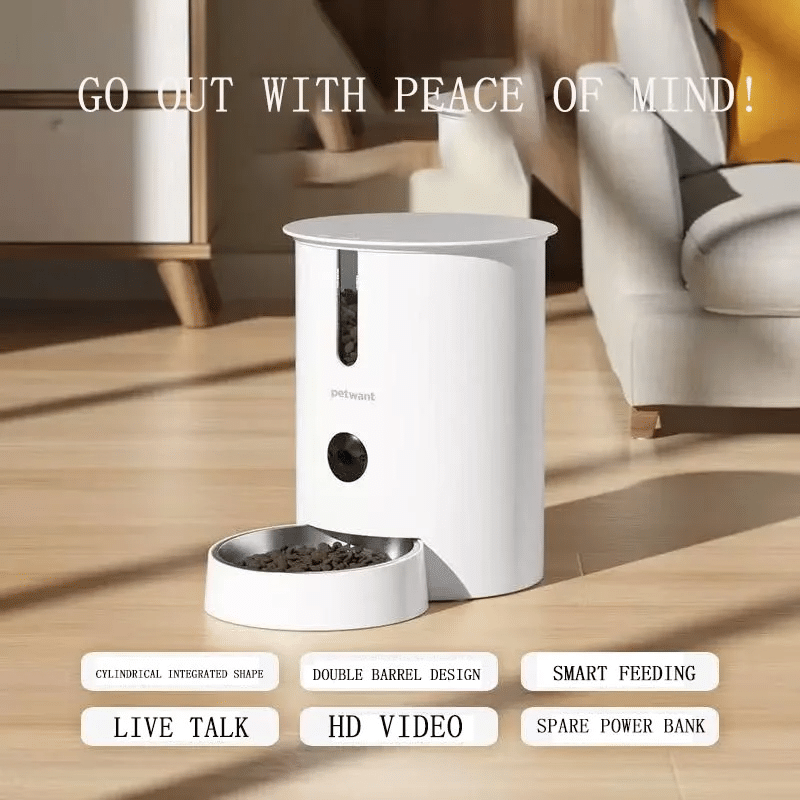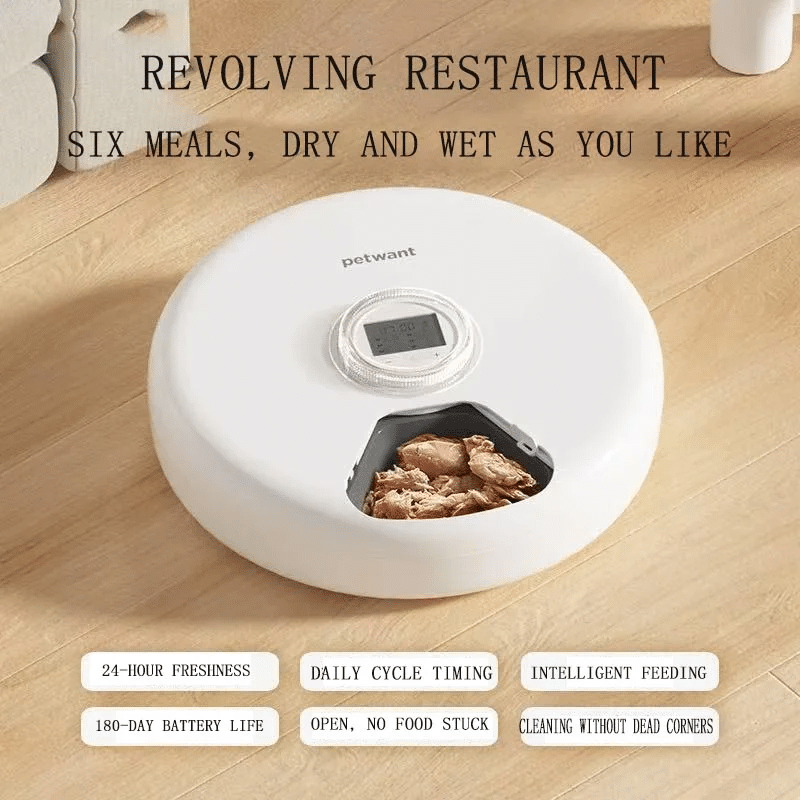With the acceleration of the pace of modern life and the global penetration rate of pet families exceeding 40%, one of the core problems faced by pet owners is how to ensure regular and healthy eating of companion animals. Intelligent feeder technology is rapidly evolving from basic timed feeding to multimodal interaction, health management and ecological sustainability, and is reshaping the pet feeding paradigm. This article analyzes the innovation and challenges in this field from three dimensions: technical architecture, design concepts and future trends.
- Technology evolution of pet feeders: paradigm transition from mechanical timing to AI-driven
Early feeders relied on simple mechanical clock to control the flip-board structure, which could only achieve fixed-time blanking. The current system has developed into a complex agent that integrates environmental perception, decision-making algorithms and human pet interaction:
Offline intelligent feeder: represented by the WTR096-28SS voice chip solution, replacing discrete components through high-integration design. The chip integrates voice prompts (90 seconds storage), digital tube display and clock functions in a single module, supports serial command control of feeding plans, and can relieve pet separation anxiety through recording playback 3. System power consumption is reduced by about 30%, and cost is reduced to 60% of traditional solutions
Networked cloud platform system: STM32 or C51 microcontroller is used as edge nodes and connects to the cloud through the ESP8266 Wi-Fi module. Sensor data (temperature, humidity, weight, image) is uploaded to Jizhi Cloud or Alibaba Cloud platform, and after analysis, it generates a feeding report and triggers an abnormal alarm.
Energy technology innovation: Solar feeders are equipped with 4-5V photovoltaic panels and 3.7V lithium batteries. They can charge 4 hours in sunny days to support 72 hours in rainy days, achieving zero carbon feeding in off-grid environments

- Technical analysis of core functional modules
The intelligence of modern pet feeders relies on the collaboration of multiple subsystems, and key technological breakthroughs are reflected in three aspects:
2.1. Accurate feeding control system
Servo + Weighing Closed Loop: The servo controls the opening and closing angle of the baffle (adjustable from 0-180°), and achieves ±2g precision feeding with the pressure sensor. When the residual grain exceeds the threshold, the feeding volume of the next meal will be automatically reduced
Wet grain preservation solution: The special canned feeder adopts a rotary cap robot arm + lifting device to fix the tank body through the first limiting part, and the rotary cap body of the second limiting part realizes automatic opening and closing to avoid oxidation and deterioration.
2.2. Health monitoring sensor network
Temperature and humidity sensor monitors the grain storage environment, and starts PTC heating and dehumidification when exceeding the standard
Infrared sensor detects feeding frequency, and captures chewing behavior with camera
The data analysis platform generates health index through parameters such as eating speed and left-over food, and warns of diabetes, hyperthyroidism and other diseases.
2.3. Upgrade of human pet interaction experience
The two-way voice module supports the owner to call remotely, and plays the recording before feeding to establish conditioned reflex.
Slow food and anti-spreading design adopts spiral maze structure or adjustable partition, extending the eating time by 40%-60%, reducing the risk of gastric torsion
- Innovation in design concept: from functional realization to health philosophy
Frontier design has gone beyond the basic function of “feeding” and turned to focusing on pet mental health and behavioral correction:
Ethical design of slow food and prevent scattering: In response to the digestive problems caused by the swallowing instinct of canines, the eating speed is forced to slow down through the three-dimensional raised structure and multi-cavity separation. Experiments show that the average Labrador Retriever’s feeding time can be extended from 1.2 minutes to 4.5 minutes.
Mechanism for relief of separation anxiety: 72% of pets develop stress behavior after their owners leave home. Feeder integrates AI interactive game, activates the missing ball mode when the pet is detected, and combines the camera for positive behavioral training.
Sustainable materials application: Grain storage silos adopt food-grade PP + rice husk fiber composite material, both sealing and degradable; cardboard shell feeder reduces plastic usage by more than 60%
- Technical challenges and solutions
The system is still facing three major bottlenecks, and innovative solutions are emerging:
Multiple pet identification problems
Traditional equipment cannot distinguish individuals, resulting in an imbalance in group feeding. The new solution adopts RFID collar scanning or nose pattern recognition technology, combined with the split bin design to achieve personalized feeding
Wet grain adhesion control
Meat paste foods are easily stuck to the outlet. The residual rate is reduced to 0.8% through a composite scheme of piezoelectric ceramic vibrator + Teflon coating.
Complex environment adaptability
IP65 protective feeder developed for outdoor scenes uses dual bearing sealing servo and wide temperature domain battery (-20℃~60℃), and the windproof fixing claw is triggered through the wind speed sensor.

- Future trends: From feeding tools to health management centers
- Feeders are evolving into the entrance to pet health ecology, and three directions are worth paying attention to:
Multimodal health monitoring: Integrated tongue spot identification to evaluate dehydration status, chewing voiceprint analysis to diagnose dental diseases, and scale module tracks body fat changes
AI personalized nutrition plan: In conjunction with the pet hospital database, custom recipes are generated based on variety, age, and medical history, and automatic mixing of prescription grains and probiotic addition ratios
Metauniverse interaction expansion: Through AR glasses and holographic projection, the owner’s virtual image is accompanied to eat, and emotional parameters are fed back to the feeding strategy
Pudding, a blue cat who had vomited frequently due to eating too quickly and frequently, increased the feeding time from 2 minutes to 9 minutes after using a slow-food feeder, and the vomiting frequency decreased by 90%. This case reveals the core value of intelligent feeding equipment: technology is not a cold machinery, but a gentle protection of life rhythm.

